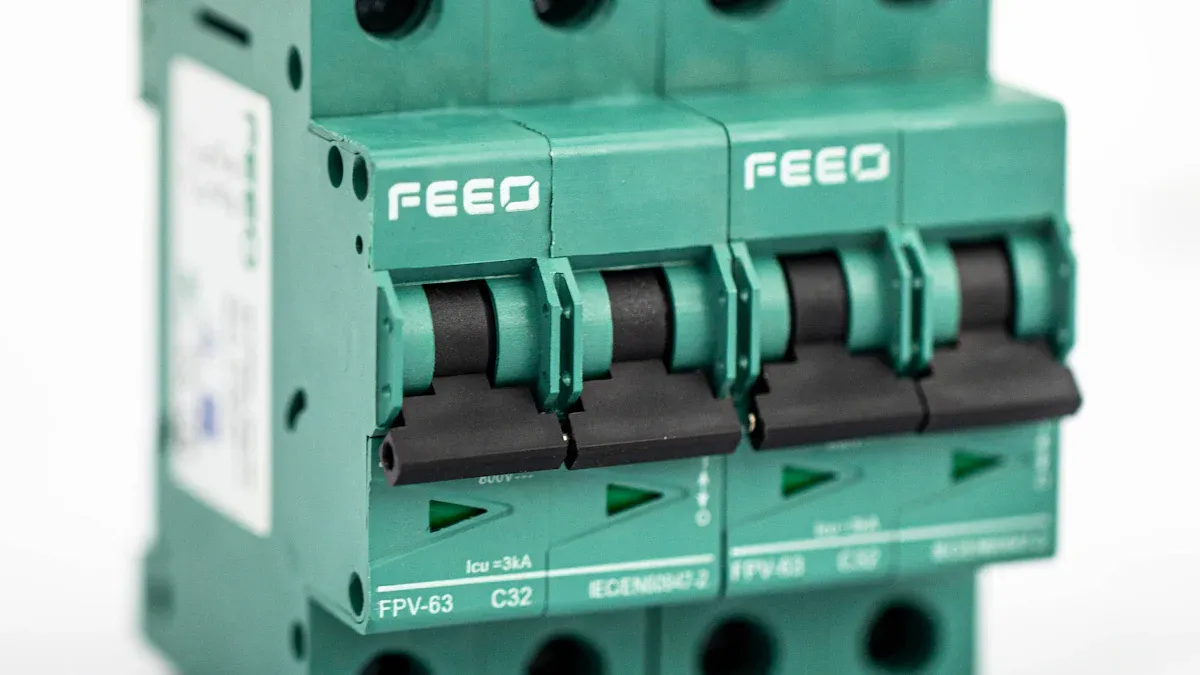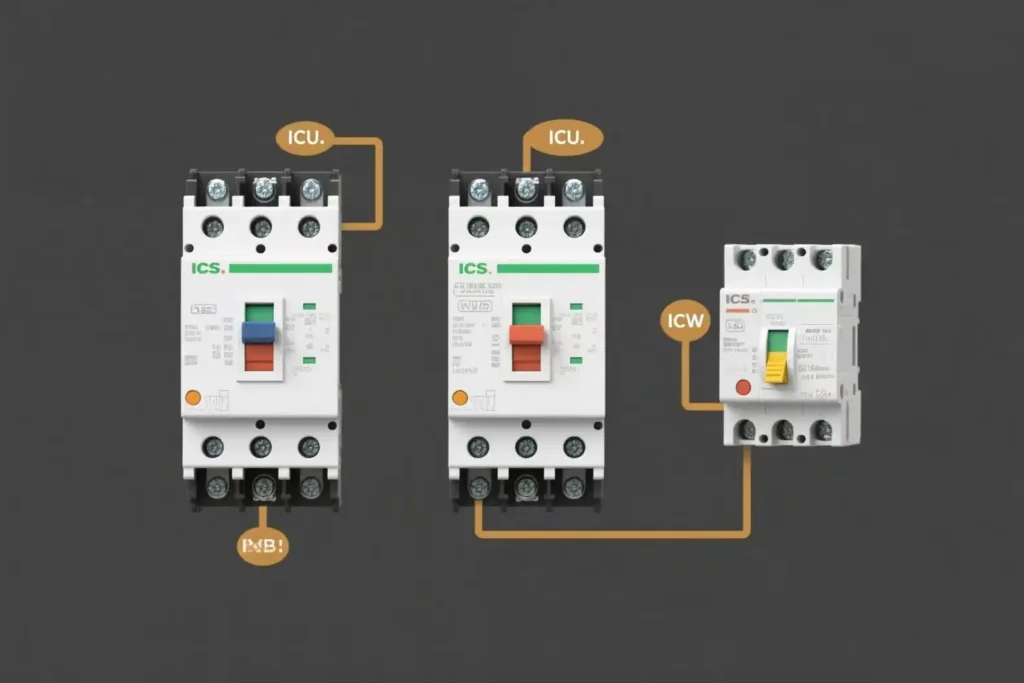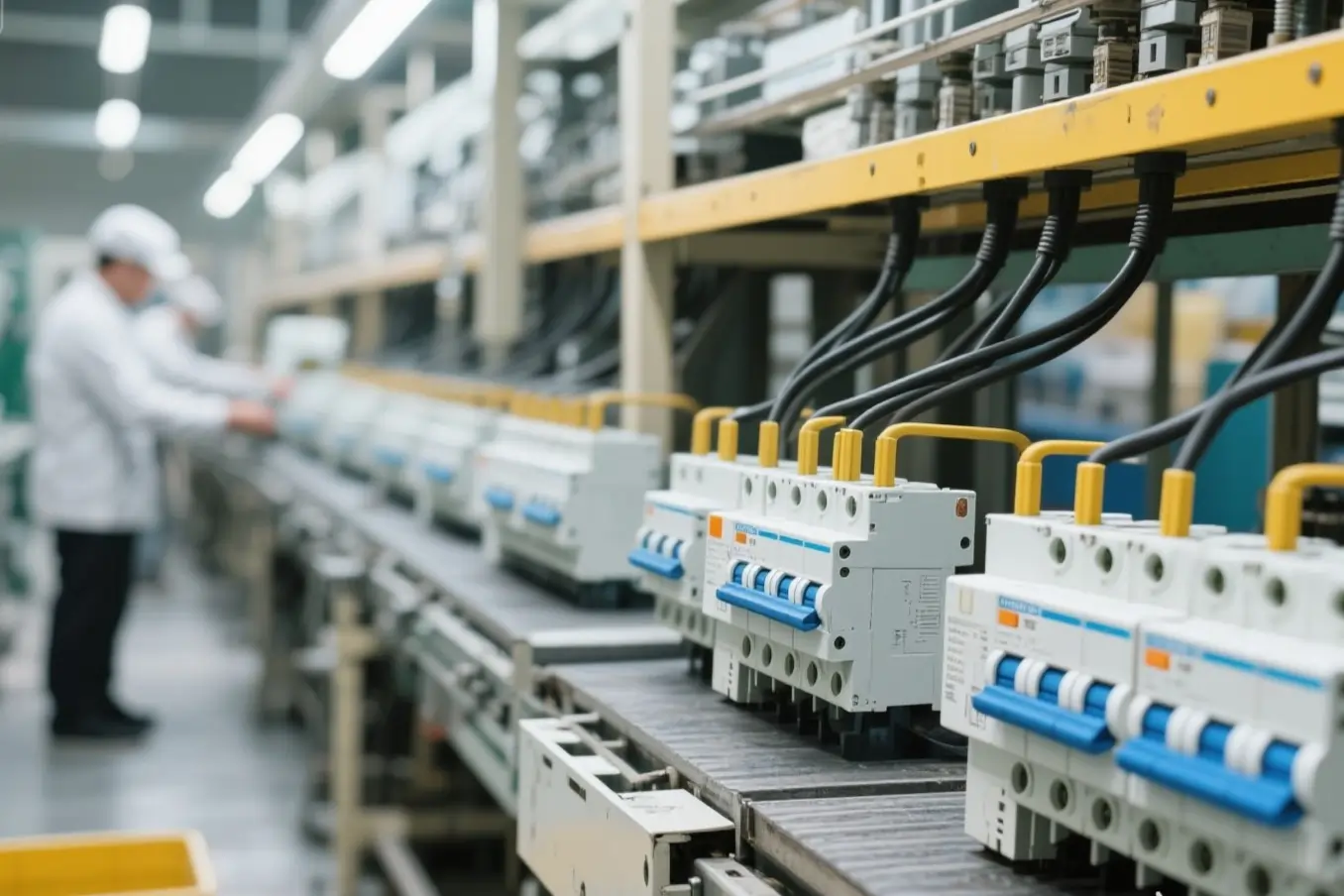The main difference between ICS, ICU, and ICW in circuit breakers is how each one measures the breaker’s strength. ICS shows the current a breaker can stop many times and still work well. ICU is the biggest current the breaker can stop just one time. ICW tells how much current the breaker can handle for a short time without turning off. Knowing these ratings is important because if ICS is lower than ICU, the breaker might need to be replaced after a problem. This can affect how safe and reliable the system is.
| Parameter | Meaning | Typical Value | Why It Matters |
|---|---|---|---|
| ICS | Breaker can stop this current many times and still work | 75 kA (75% of ICU) | Makes sure the breaker works during repeated problems |
| ICU | Breaker can stop this current one time | 100 kA | Shows the biggest problem the breaker can handle before it needs to be replaced |
| ICW | Breaker can handle this current for a short time | 50 kA for 1 second | Helps with planning and keeping the system steady |
Key Takeaways
- ICS tells us how many times a breaker can stop a problem and still work. This helps keep systems working well.
- ICU is the biggest current a breaker can stop one time without breaking. This keeps the system safe from big problems.
- ICW shows how much current a breaker can take for a short time without opening. This helps keep the system safe and working together.
- Picking breakers with the right ICS, ICU, and ICW ratings keeps systems safe and stops expensive problems.
- Always check breaker ratings to match your system’s needs. Follow rules like IEC 60947-2 for the best safety.
ICS
Meaning
ICS means rated service short-circuit breaking capacity. This rating tells us how much current a circuit breaker can safely stop many times. The breaker will still work after stopping these currents. Industry rules like IEC 60947-2 and GB14048.2—94 explain ICS. ICS is about stopping fault currents again and again without breaking. ICS is not the same as ultimate breaking capacity. Ultimate breaking capacity is the biggest current the breaker can stop only once. To test ICS, people use a special order called O-t-CO. This means open, wait, close, and open again. This test checks if the breaker stays safe after stopping big fault currents. ICS is usually shown as a part of the ICU rating. It is often between 25% and 100%.
Importance
ICS is important because it shows how well a breaker works during many faults. If ICS is high, the breaker can handle many short circuits and still protect things. This keeps machines safe and stops long breaks in work. If ICS is low, the breaker may need to be changed after one or two faults. Rules say ICS must fit what the building needs. This way, the breaker keeps working after strong faults. ICS helps engineers pick the right breaker for safety and for using it a long time.
Note: ICS ratings are always given in kiloamperes (kA). They also think about things like voltage and power factor.
Application
Engineers look at ICS ratings when picking breakers for different setups. For example, a substation with one transformer that is 250 kVA and needs an ICU of 50 kA would use a breaker like Compact NSX400N. In bigger systems with more transformers, ICS helps choose the best breaker model. The table below shows how ICS helps pick breakers in real life:
| Installation Scenario | Transformer Rating (kVA) | Required ICU (kA) | Recommended Breaker Model |
|---|---|---|---|
| Single transformer in consumer substation | 250 | 50 | Compact NSX400N (Icu = 50 kA) |
| Parallel transformers (2 x 400 kVA) | 2 x 400 | 14 (CBM), 28 (CBP) | MTZ1 08H1 / NS800N (CBM), NSX100-630F (CBP) |
| Parallel transformers (3 x 400 kVA) | 3 x 400 | 28 (CBM), 42 (CBP) | MTZ1 08H1 / NS800N (CBM), NSX100-630N (CBP) |
| Parallel transformers (2 x 800 kVA) | 2 x 800 | 19 (CBM), 38 (CBP) | MTZ1 12H1 / NS1250N (CBM), NSX100-630N (CBP) |
This table shows ICS helps match the breaker to what the system needs. It makes sure the breaker can handle many faults and keeps everything safe.
ICU
Definition
ICU means “ultimate short-circuit breaking capacity.” It shows the biggest current a breaker can safely stop in a short circuit. ICU is measured in kiloamperes (kA) root mean square (rms). The IEC 60947-2 standard explains what ICU is and how to measure it. The Masterpact guide says ICU must be at least as high as the biggest three-phase short-circuit current at the spot where it is used. This number is not likely to be higher in real life. The ICU rating tells people the largest fault current the breaker can stop without getting hurt.
Role
ICU is very important when picking a breaker and keeping things safe. It makes sure the breaker can handle the worst fault current in the system. If the ICU is too low, the breaker might not work in a big short circuit. This could break equipment or cause danger. Experts say engineers must figure out the biggest short-circuit current by checking transformer size, source impedance, and wire lengths. Then, they pick a breaker with an ICU that is the same or higher. This helps stop failures and keeps the system working well.
Tip: Always pick an ICU rating that matches the highest fault current in your system to stay safe.
Testing
Manufacturers test ICU ratings using strict rules from IEC 60947-2. The rules say breakers must stop the rated short-circuit current in a set order. After testing, the breaker must still give isolation, keep its strength, and work right for overloads. Testing also looks at the phase difference between current and voltage, because it is harder to break at low power factors. In the United States, UL 489 has similar rules and needs many good operations at the biggest fault current. These tests show the breaker can handle big faults and still protect things.
- Manufacturers use statistics to check if ICU ratings are reliable.
- Tests have repeated actions and check how the breaker works after faults.
- Results show ICU ratings stay the same and work for different breakers and tests.
This careful testing makes sure ICU ratings show what a breaker can really do in real life.
ICW

What It Is
ICW means “rated short-time withstand current.” This tells us how much short-circuit current a breaker can take for a short time, usually one second. The breaker will still work after this. The technical paper “The essence of LV circuit breakers – Releases, tripping curves, characteristics and limitation” says ICW is important for category B circuit breakers. These breakers must stay closed during a short fault. This lets another device fix the problem first. The breaker can only stay closed if the fault energy does not go over the ICW value for that time. ICW is measured in kiloamperes (kA). It is connected to the heat the breaker can handle.
Significance
ICW helps engineers check if a breaker can handle the heat and force from a short circuit for a short time. This matters when the breaker needs to wait before opening. Another device might need to clear the fault first. If the ICW rating is too low, the breaker could get hurt or not protect the system. ICW also helps with selectivity. Selectivity means only the closest device to the fault opens. The other devices stay closed. This keeps the rest of the system working. ICW ratings help engineers plan safe and steady power systems.
Note: Only category B circuit breakers have ICW ratings. These are used with other protection devices in a row.
Use Cases
ICW ratings are used in many real-life jobs. Engineers use ICW to pick breakers for motor protection, line protection, and systems with backup fuses. The ICW value must fit the system and the delay time set for the breaker. The table below shows how ICW matches with other ratings:
| Rated Breaking Capacity (Icu) Range | Power Factor (cos φ) | Rated Making Capacity (Icm) Factor |
|---|---|---|
| 6 kA < Icu ≤ 10 kA | 0.5 | 1.7 × Icu |
| 10 kA < Icu ≤ 20 kA | 0.3 | 2 × Icu |
| 20 kA < Icu ≤ 50 kA | 0.25 | 2.1 × Icu |
| 50 kA ≤ Icu | 0.2 | 2.2 × Icu |
A Masterpact NW08H2 breaker with an Icu of 100 kA has an Icm of 220 kA (100 × 2.2). This shows how engineers use ICW and Icm to make sure breakers can handle short-time currents. In Siemens line protection, ICW settings help work with backup fuses and switchgear. The chart below shows how power factor and Icm factor change with different Icu values:
ICW ratings help keep systems safe during short faults. They also let engineers plan delays. This makes ICW very important in many electrical systems.
Comparison
Table
The table below shows how ICS, ICU, and ICW are different. It explains what each rating means, how they are tested, and why they matter. You can also see what these ratings mean when used in real life.
| Rating | Definition | Test Sequence | Typical Ratio or Value | What It Means in Practice |
|---|---|---|---|---|
| ICU | Ultimate short-circuit breaking capacity. This is the highest current a breaker can safely stop. | O – t – CO | Baseline (100%) | Shows the biggest fault current the breaker can stop. After this, the breaker might not work again. |
| ICS | Service short-circuit breaking capacity. This is the highest current a breaker can stop and still work after. | O – t – CO – t – CO | 25% to 100% of ICU | Shows if the breaker can handle many faults and keep working. |
| ICW | Short-time withstand current. This is the current the breaker can take for a short time without tripping. | 0.05 to 1 second (IEC 60947-2) | Independent value | Shows how long the breaker can stay closed during a fault. This helps with selectivity and working together with other devices. |
Note: ICS and ICU are both measured as root-mean-square (rms) values. ICW is not about breaking, but about how much current it can take. These ratings help engineers pick the right breaker for safety and system needs.
Selection Tips
When picking a circuit breaker, engineers check some important things:
- Figure out the highest fault current at the place where the breaker will go. Use IEC 60909-0:2016 to do this.
- Make sure the ICU rating is at least as high as the fault current you found. This stops big problems if a major fault happens.
- Check the ICS rating. A higher ICS means the breaker can handle more faults and keep working. Many experts say to pick ICS at 75% or 100% of ICU for important systems.
- Look at the ICW rating if the system needs selectivity. If you need the breaker to trip after a delay, pick one with the right ICW value. This is common when there is backup protection or when only the closest breaker should trip.
- Think about the environment. Hot places or small spaces can make breakers work less well. Use IEC 60890:2014 to lower ratings if needed.
- For important places like hospitals or data centers, use breakers that are easy to fix or replace, like draw-out types.
- Some systems need breakers with smart features for checking and talking to other devices.
Tip: Always check the breaker’s ratings after putting it in a panel or cabinet. The way it is mounted can change the ratings.
Common Mistakes
People sometimes make mistakes when picking circuit breakers. Here are some common errors:
- Picking the wrong type of breaker for the job. Each type works in its own way.
- Making breakers too big to stop false trips. This can make protection worse. Use the right time delay instead.
- Putting breakers too close together. This can make them too hot and lower their rating.
- Asking for too much IP protection. This can cost more but may not help.
- Not lowering ratings for hot or cold places. This can make the breaker unsafe.
- Lowering ratings when it is not needed. Not all breakers need the same changes.
- Picking a breaker with too high a breaking capacity. This can cost more and may not fit the system.
- Mixing up fuses and circuit breakers. They protect in different ways and should be used right.
Warning: Picking the wrong circuit breaker can cause safety problems, broken equipment, and not following IEC safety rules.
ICS, ICU, and ICW each measure a circuit breaker’s strength in a different way. ICS tells how often a breaker can stop a fault and still work well. ICU is the biggest current the breaker can stop one time. ICW shows the current the breaker can take for a short time.
Always look at datasheets and follow rules before picking a breaker.
Checklist for professionals:
- Check all ratings with what the system needs
- Make sure breaker ratings fit the fault levels
- Look at how and where the breaker will be used
- Read IEC 60947-2 for more information
If you need to purchase high-quality circuit breakers, you can check out our circuit breaker product line
FAQ
What does ICS mean in a circuit breaker?
ICS shows the current a breaker can stop many times and still work. This rating helps users know if the breaker will keep protecting the system after several faults.
What is the main difference between ICU and ICS?
ICU is the largest current a breaker can stop one time. ICS is the current it can stop many times and still work. ICS is always less than or equal to ICU.
What does ICW tell about a circuit breaker?
ICW tells how much current a breaker can handle for a short time without opening. This helps engineers plan for delays and keep the system safe during short faults.
What happens if ICS is lower than ICU?
If ICS is much lower than ICU, the breaker might need replacement after a big fault. The breaker may not work again if another fault happens soon after.
What standard explains ICS, ICU, and ICW ratings?
IEC 60947-2 explains ICS, ICU, and ICW ratings. This standard helps engineers and electricians choose the right breaker for safety and system needs.
The following information may be of interest to you
Best Solar Energy Kits for Reliable Power Solutions
Are all MC4 connectors the same?
How to connect solar panels to 12 volt batteries and inverters
How to Perform Maintenance on Air Circuit Breakers in 2025
How to wire a 50 ampere automatic transfer switch




